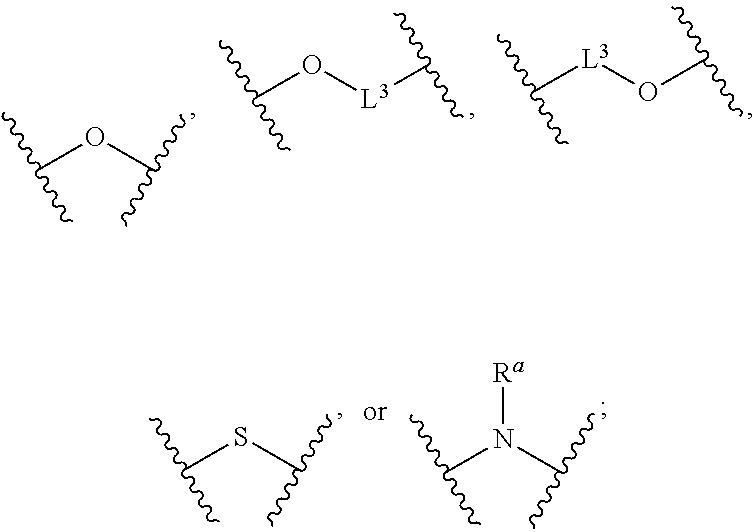Compounds and uses thereof
a technology of compounds and active ingredients, applied in the field of compounds and uses thereof, can solve the problems of limited robust model system arsenal, inability to generate successful disease-modifying therapies against common and progressive neurological disorders, and provide very little reli
- Summary
- Abstract
- Description
- Claims
- Application Information
AI Technical Summary
Benefits of technology
Problems solved by technology
Method used
Image
Examples
example 1
on of N-(4-(3-fluorobenzyl)phenyl)-1-methyl-6-oxo-1,4,5,6-tetrahydropyridazine-3-carboxamide (1)
[0627]
Step 1: Preparation of 4-(3-fluorobenzyl)aniline
[0628]
[0629]To a solution of 1-(bromomethyl)-3-fluorobenzene (2.0 g, 10.6 mmol), 4-(4,4,5,5-tetramethyl-1,3,2-dioxaborolan-2-yl)aniline (2.33 g, 10.4 mmol), potassium carbonate (2.93 g, 21.3 mmol) acetonitrile (60 mL) and water (10 mL) was added [1,1′-bis(diphenylphosphino)ferrocene]dichloropalladium(II)-dichloromethane (0.868 g, 1.06 mmol) under nitrogen. The mixture was heated to 90° C. and stirred for 2 h. The volatiles were removed under reduced pressure. Aqueous layer was acidified to pH=1-3 with 1 N hydrogen chloride and extracted with ethyl acetate (50 mL). The aqueous layer was then re-adjusted to pH=8-10 with aqueous sodium bicarbonate and extracted with dichloromethane (50 mL×2). The combined dichloromethane layers were dried over sodium sulfate, filtered and concentrated. Purification by column chromatography (silica gel, (p...
example 2
on of N-(4-(3-chlorobenzyl)phenyl)-1-methyl-6-oxo-1,4,5,6-tetrahydropyridazine-3-carboxamide (2)
[0632]
[0633]Step 1: Preparation of 4-(3-chlorobenzyl)aniline
[0634]To a solution of 1-(bromomethyl)-3-chlorobenzene (2.0 g, 9.81 mmol), 4-(4,4,5,5-tetramethyl-1,3,2-dioxaborolan-2-yl)aniline (2.15 g, 9.81 mmol), potassium carbonate (2.71 g, 19.6 mmol) in acetonitrile (16 mL) and water (4 mL) was added 1,1′-bis(diphenylphosphino)ferrocene-palladium(II)dichloride dichloromethane (0.800 g, 0.981 mmol) under nitrogen. The mixture was heated to 90° C. and stirred for 2 h. The volatiles were removed under reduced pressure and the slurry was acidified to pH=1-3 with aqueous 1 N hydrogen chloride and extracted with ethyl acetate (50 mL). The aqueous layer was then adjusted to pH=8-10 with aqueous sodium bicarbonate and extracted with dichloromethane (50 mL×2). The combined dichloromethane layers were dried over sodium sulfate, filtered and concentrated to give 4-(3-chlorobenzyl)aniline as a yellow...
example 3
on of N-(4-(3-chlorobenzyl)phenyl)-1-methyl-6-oxo-1,6-dihydropyridazine-3-carboxamide (3)
[0637]
Step 1: Preparation of 4-(3-chlorobenzyl)aniline
[0638]
[0639]To a solution of 1-(bromomethyl)-3-chlorobenzene (2.0 g, 9.81 mmol), 4-(4,4,5,5-tetramethyl-1,3,2-dioxaborolan-2-yl)aniline (2.15 g, 9.81 mmol), potassium carbonate (2.71 g, 19.6 mmol) in acetonitrile (16 mL) and water (4 mL) was added 1,1′-bis(diphenylphosphino)ferrocene]dichloropalladium(II)dichloromethane complex (0.800 g, 0.981 mmol) under nitrogen. The mixture was heated to 90° C. and stirred for 2 h. The volatiles were removed under reduced pressure and the slurry was acidified to pH=1-3 with aqueous 1 N hydrogen chloride and extracted with ethyl acetate (50 mL). The aqueous layer was then adjusted to pH=8-10 with aqueous sodium bicarbonate and extracted with dichloromethane (50 mL×2). The combined dichloromethane layers were dried over sodium sulfate, filtered and concentrated to give 4-(3-chlorobenzyl)aniline (0.800 g, cru...
PUM
| Property | Measurement | Unit |
|---|---|---|
| Structure | aaaaa | aaaaa |
| Toxicity | aaaaa | aaaaa |
Abstract
Description
Claims
Application Information
 Login to View More
Login to View More - R&D
- Intellectual Property
- Life Sciences
- Materials
- Tech Scout
- Unparalleled Data Quality
- Higher Quality Content
- 60% Fewer Hallucinations
Browse by: Latest US Patents, China's latest patents, Technical Efficacy Thesaurus, Application Domain, Technology Topic, Popular Technical Reports.
© 2025 PatSnap. All rights reserved.Legal|Privacy policy|Modern Slavery Act Transparency Statement|Sitemap|About US| Contact US: help@patsnap.com



